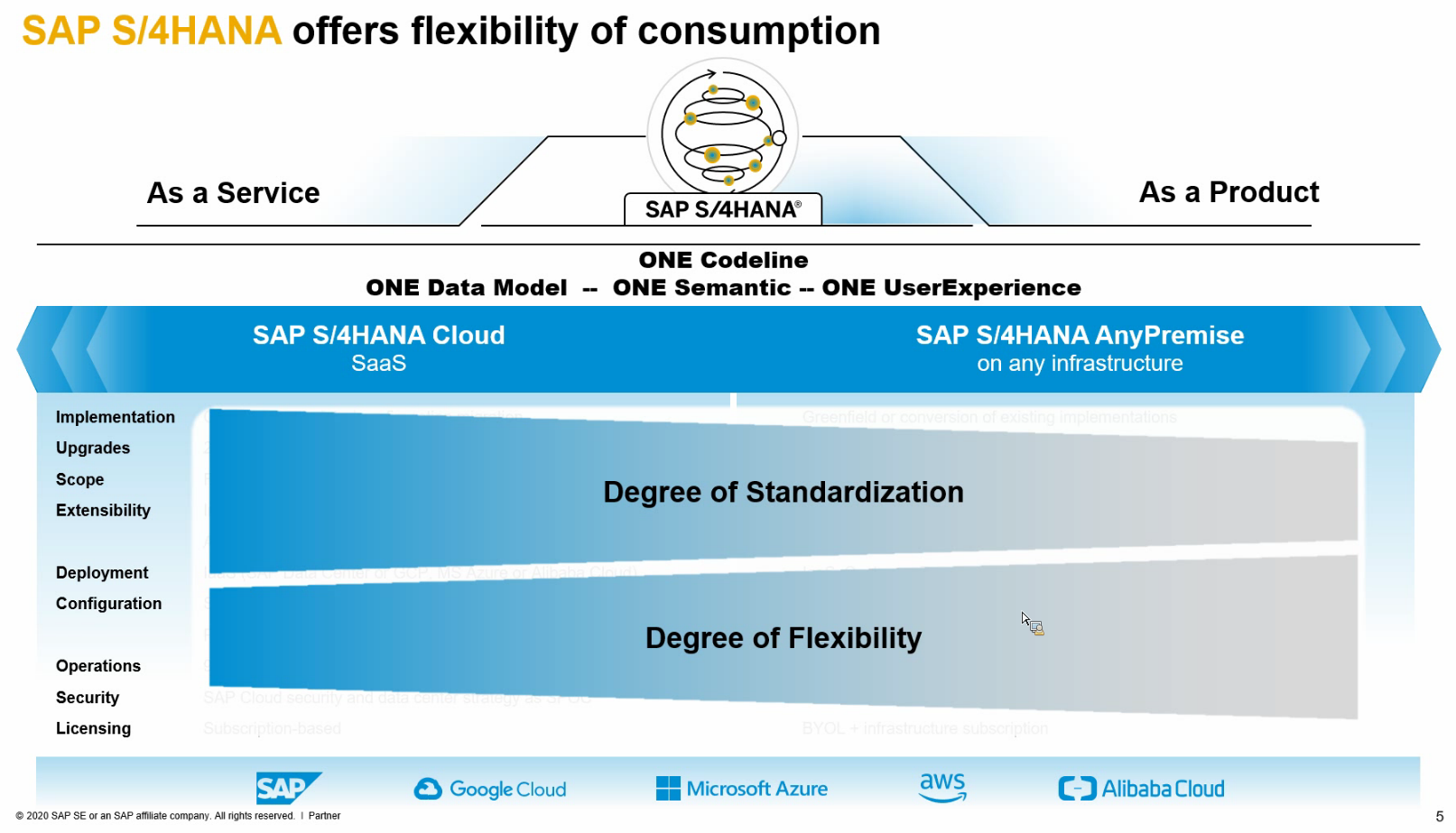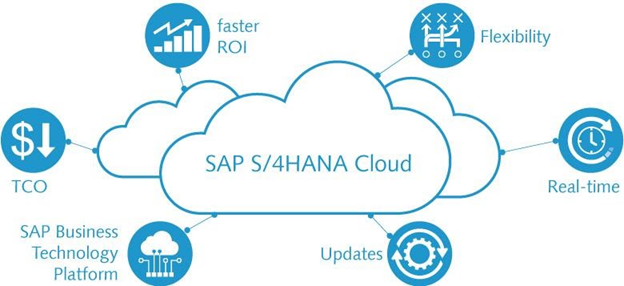Top 7 Reasons to Use SAP BTP along with SAP S/4HANA
02-Nov-2022
The practical implications of SAP S/4HANA continue to revamp businesses across the globe. With the onset of SAP’s fourth version of this ERP suite, organizations have quickly adapted to the future of cloud operations with this reliable software.
The platform allows businesses to simplify business operations and streamline the digital economy.
How does SAP S/4HANA Add to Businesses?
Most businesses today are aware of the key value-adding features of SAP S/4HANA. However, that’s not all! There are several other added benefits of leveraging the leading cloud-based ERP, including management and administration simplification and centralization, user-friendliness, economic viability, innovative thinking, performance improvement and speed, and an all-around seamless migration from on-premise to the cloud.

Source: https://blogs.sap.com/
According to SAP implementation partners, S/4HANA is their in-memory database and intelligent ERP system that operates on SAP HANA. Through its streamlined data model and intelligent automation, this technology has the potential to alter both business and IT activities, delivering extraordinary results.
When switching to SAP S/4HANA, the following seven business advantages are of the utmost importance:
1. Amplify Your Strategic Decisions With Simple, Comprehensive Data Warehousing Solutions
With SAP implementation partners, Data Warehouse Cloud, and SAP BW/4HANA, you can provide self-service modeling and analytics for all data types across cloud and on-premise data.
2. Achieve A Complete 360° Insight Over A Single Analytics Platform
You may use a single integrated solution for planning, analysis, and execution for SAP S/4HANA, and SAP Analytics Cloud can speed up data-driven decision-making.
3. Tap Into SAP S/4HANA Cloud To Access Better Insights & Predictions
With in-memory advanced analytics using SAP HANA or SAP HANA Cloud, you can provide real-time, reliable, and trusted insights from SAP and non-SAP data.
4. Integrate SAP S/4HANA Cloud & Applications Seamlessly Into Your Landscape
The SAP Integration Suite makes integrating all data and processes between cloud-based, on-premises, and third-party applications easier.
5. Extend S/4HANA’s Cloud To Innovate With A Clean Digital Core
With ready-to-use services, prebuilt content, and automation from SAP Extension Suite, you can quickly create and improve apps and processes while keeping your SAP S/4HANA digital core tidy.
6. Improvise Data Migration With Proven Solutions & Best Practices
With SAP Advanced Data Migration by Syniti cloud edition and SAP Data Services, you may combine data from several legacy ERP systems into a single SAP S/4HANA system.
7. Implement Data-Driven Decisions With Confidence By Leveraging A Reliable Master Data
With SAP Master Data Governance, you can guarantee high-quality, current data checked at every level.
Primary Business Benefits of Using SAP S/4HANA
Source: https://itpfed.com/
According to experts, the major benefits of SAP S/4HANA for organizations include quicker analytics and cost-effective flexibility, thanks to HANA’s in-memory database. Additionally, the system can be simpler to operate compared to ECC and make moving to the cloud less complicated. Some of the top business advantages of SAP S/4HANA are listed below:
Updating Business Models Becomes Simplified
SAP ECC was created for businesses that didn’t adapt as quickly as they do now to keep up with various factors, such as supply chain disruptions, cutting-edge technology, rising customer demands, and hybrid workforces.
However, SAP S/4HANA gives businesses greater opportunities to utilize data and redefine new business models, simplifying business model changes. Built from scratch, SAP S/4HANA considers how businesses operate today.
This platform makes it simpler and faster to enter these new markets, whether you wish to make adjustments, buy businesses, or [create] new sales channels.
Speeding-Up of Analytical Insights
S/4HANA’s in-memory database, HANA, allows for dramatically better speed. According to Low, its intelligent data design minimizes data redundancy and aggregates tables for increased efficiency. As a result, the basic ERP system now offers analytics and quicker insights rather than storing data in warehouses and uploading them over some time.
Low argued that having analytics capabilities and business transactions in a similar fashion speeds up insights.
This eliminates the need to switch between systems and apps and enables businesses to swiftly and easily make choices and complete business activities in a single application utilizing a single data source. It saves a ton of time and is efficient.
Increased Forecasting Accuracy
S/4HANA’s ML (Machine Learning) and embedded AI applications are developing gradually but rapidly to enhance modeling, predictive results, and forecasting.
For instance, a merchant might utilize the UDEF (Universal Data Element Framework) to estimate demand based on previous data and incorporate external variables like the changing weather.
This way, the retailer might create a model to forecast the demand for a specific product in a given area.
Streamlined User Interface
For more than 20 years, SAP BTP didn’t give up on its GUI, the recognizable user interface. However, Low added that SAP did revamp it for S/4HANA to represent improved business processes better.
Additionally, businesses can do typical business processes on iOS and Android devices using the SAP Fiori user interface, an HTML5-based (SAPUI5) platform that is either integrated into S/4HANA or offered as a separate module.
Timely Maintenance of Assets
Companies can now integrate industrial IoT sensors alongside their S/4HANA ERP to amplify predictive analytics, especially for manufacturing units to receive warnings and monitor assets in case of a machinery malfunction.
This is made possible by the in-memory database, machine learning, and AI. The sensors detect movement, temperature, and vibration continuously around the clock.
Depending on the specific baseline measures, businesses can forecast when the machinery needs maintenance or could malfunction to prevent more expensive repairs or unforeseen shutdowns.
Lower Expenses for Maintenance
S/4HANA integrates master data governance and global available-to-promise (Global ATP) services into the core. Lower ownership and maintenance costs from an infrastructure standpoint result from managing fewer boxes.
According to Roan Low, SAP BTP solutions architect at managed cloud provider Syntax, businesses can move ahead of their set infrastructures that need to be upgraded after every five years, thanks to the shared infrastructure made possible by S/4HANA. In addition, with SAP’s virtualization and public or private cloud deployments, businesses may combine their infrastructure.
According to Low, switching from the outdated physical infrastructure to the more cloud-native environment provided by S/4HANA will help businesses realize an 11% to 17% reduction in IT expenses. But preparation is essential. He advised that failing to prepare the migration properly could result in cost overruns while upgrading from ECC or any other ERP system.
Automation of Boring Tasks
The SAP S/4HANA offers simplified process automation, enabling enterprises to automate regular processes previously completed manually, such as running reports, freeing employees to concentrate on more productive activities. In addition, business operations can be accelerated and streamlined by using RPA (Robotic Process Automation) solutions.
Higher Speed for Period Closings
A faster database should result in quicker end-of-period closings for the financials. In addition, businesses can obtain reports that reflect their current financial situation and real-time accounting reconciliation. S/4HANA also enables companies to perform predictive accounting using AI and machine learning.
Acquisition Integration into the ERP Environment is Easier
In consumer packaged goods, businesses acquire smaller brands to enter new markets and add complementary products to their lineup.
Before SAP S/4HANA, they had to integrate these acquisitions into their primary ECC systems, which required significant time and money. Businesses can maintain acquisitions on the SAP public cloud with S/4HANA rather than having to integrate them into their core operations.
Bottom Line
Enterprises migrating to S/4HANA may offer the flexibility to include new acquisitions, proactively manage assets, and eliminate tiresome chores from their workers’ workdays, whether designing a greenfield approach to the S/4HANA deployment.












